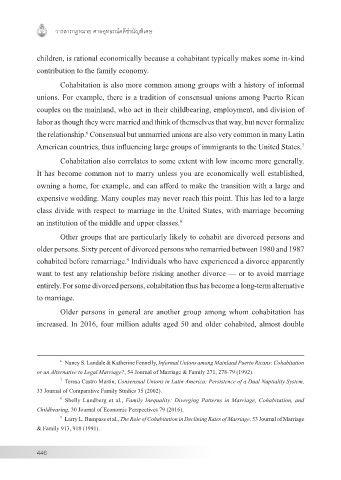Page 448 - วารสารกฎหมาย ศาลอุทธรณ์คดีชํานัญพิเศษ
P. 448
วารสารกฎหมาย ศาลอุทธรณ์คดีชำานัญพิเศษ
children, is rational economically because a cohabitant typically makes some in-kind
contribution to the family economy.
Cohabitation is also more common among groups with a history of informal
unions. For example, there is a tradition of consensual unions among Puerto Rican
couples on the mainland, who act in their childbearing, employment, and division of
labor as though they were married and think of themselves that way, but never formalize
the relationship. Consensual but unmarried unions are also very common in many Latin
6
American countries, thus influencing large groups of immigrants to the United States.
7
Cohabitation also correlates to some extent with low income more generally.
It has become common not to marry unless you are economically well established,
owning a home, for example, and can afford to make the transition with a large and
expensive wedding. Many couples may never reach this point. This has led to a large
class divide with respect to marriage in the United States, with marriage becoming
an institution of the middle and upper classes. 8
Other groups that are particularly likely to cohabit are divorced persons and
older persons. Sixty percent of divorced persons who remarried between 1980 and 1987
cohabited before remarriage. Individuals who have experienced a divorce apparently
9
want to test any relationship before risking another divorce — or to avoid marriage
entirely. For some divorced persons, cohabitation thus has become a long-term alternative
to marriage.
Older persons in general are another group among whom cohabitation has
increased. In 2016, four million adults aged 50 and older cohabited, almost double
6 Nancy S. Landale & Katherine Fennelly, Informal Unions among Mainland Puerto Ricans: Cohabitation
or an Alternative to Legal Marriage?, 54 Journal of Marriage & Family 271, 278-79 (1992).
7 Teresa Castro Martin, Consensual Unions in Latin America: Persistence of a Dual Nuptiality System,
33 Journal of Comparative Family Studies 35 (2002).
8 Shelly Lundberg et al., Family Inequality: Diverging Patterns in Marriage, Cohabitation, and
Childbearing, 30 Journal of Economic Perspectives 79 (2016).
9 Larry L. Bumpass et al., The Role of Cohabitation in Declining Rates of Marriage, 53 Journal of Marriage
& Family 913, 918 (1991).
446

